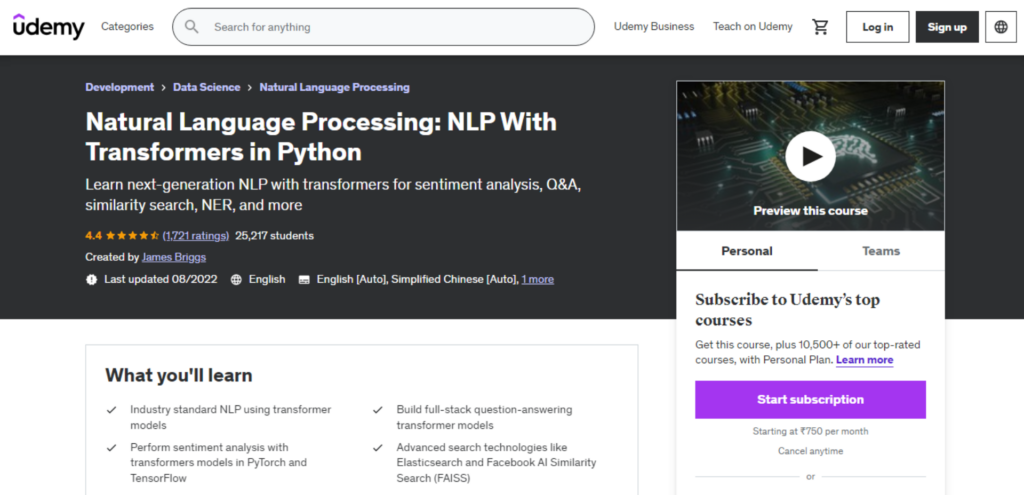- Introduction to Natural Language Processing Courses
- 1.Machine Learning: Natural Language Processing in Python (V2) by Udemy
- 2.NLP – Natural Language Processing with Python by Udemy
- 3.Data Science: Natural Language Processing (NLP) in Python by Udemy
- 4.Natural Language Processing with Deep Learning in Python by Udemy
- 5.Natural Language Processing: NLP With Transformers in Python by Udemy
- 6.Practical Natural Language Processing by Udemy (Free)
- 7.Natural Language Processing by Udemy (Free)
Introduction to Natural Language Processing Courses
NLP courses teach how computers understand human language. Students learn language modeling, sentiment analysis, and machine translation. They practice with real applications like chatbots. By the end, they can design and evaluate NLP systems, helping advance AI and language technology.
1.Machine Learning: Natural Language Processing in Python (V2) by Udemy

Lazy Programmer Inc. created this course! Learn NLP using Python with Markov Models, NLTK, AI, Deep Learning, Machine Learning, and Data Science techniques.
Machine Learning: Natural Language Processing in Python (V2)
Click Here to Know more and Register to this course.
2.NLP – Natural Language Processing with Python by Udemy

Created by Jose Portilla, this course teaches using Machine Learning, Spacy, NLTK, SciKit-Learn, Deep Learning, and more for Natural Language Processing. Master essential skills easily.
NLP – Natural Language Processing with Python
Click Here to Know more and Register to this course.
3.Data Science: Natural Language Processing (NLP) in Python by Udemy

This course, covers practical applications like deciphering codes, spotting spam, analyzing sentiments, creating article spinners, and understanding latent semantic analysis.
Data Science: Natural Language Processing (NLP) in Python by Udemy
Click Here to Know more and Register to this course.
4.Natural Language Processing with Deep Learning in Python by Udemy

Learn to create and use word embeddings like word2vec and GloVe. Also, master sentiment analysis with recursive nets. Start mastering these techniques today!
Natural Language Processing with Deep Learning in Python
Click Here to Know more and Register to this course.
5.Natural Language Processing: NLP With Transformers in Python by Udemy

Learn next-generation NLP with transformers for sentiment analysis, Q&A, similarity search, NER, and more.
Natural Language Processing: NLP With Transformers in Python
Click Here to Know more and Register to this course.
6.Practical Natural Language Processing by Udemy (Free)

Explore NLP basics with Isaac Luu! This course teaches beginners data mining, web page cleaning, and essential NLP skills. Perfect for newcomers to the field.
Practical Natural Language Processing
Click Here to Know more and Register to this course.
7.Natural Language Processing by Udemy (Free)

Dive into text and speech analysis projects with this course. Learn using Huggingface transformers, TensorFlow Hub, TextBlob, and NLP libraries. Perfect your analysis skills.
Natural Language Processing
Click Here to Know more and Register to this course.
FAQ’s
1. What is NLP?
NLP, or Natural Language Processing, is a branch of artificial intelligence that focuses on enabling machines to understand, interpret, and generate human language.
2. Why is NLP important?
NLP is essential for various applications, including chatbots, language translation, sentiment analysis, and speech recognition, making human-computer interaction more natural and efficient.
3. What are NLP techniques used for?
NLP techniques are used for tasks like text summarization, named entity recognition, language translation, and sentiment analysis, enhancing communication and data analysis capabilities.
4. Which programming languages are used in NLP?
Common programming languages for NLP include Python, Java, and R, with Python being widely favored for its extensive libraries like NLTK and spaCy.
5. How is NLP applied in real life?
NLP is applied in real life for tasks such as chatbots in customer service, language translation apps, virtual assistants like Siri and Alexa, and analyzing social media sentiments.